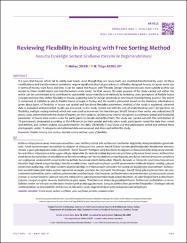| dc.contributor.author | Diker, Melisa | |
| dc.contributor.author | Akbulut, M. Tolga | |
| dc.date.accessioned | 2022-01-07T10:48:34Z | |
| dc.date.available | 2022-01-07T10:48:34Z | |
| dc.date.issued | 2021 | en_US |
| dc.identifier.citation | Diker, M., Akbulut, M.T. (2021). Reviewing Flexibility in Housing with Free Sorting Method. Megaron, 16 (2), 183-196. | en_US |
| dc.identifier.uri | https://hdl.handle.net/20.500.12508/2069 | |
| dc.description.abstract | It is seen that houses which fail to satisfy user needs - even though they are newly built- are modified/transformed by users. As these modifications and transformations sometimes require significant physical procedures in inflexibly-designed houses, it causes some loss in terms of money, work-force and time. It can be stated that houses with "Flexible Design" characteristics are more suitable as they can answer to these modifications and transformations more easily. For that reason, the main purpose of the study carried out within this article can be summarized as to contribute to sustainable house manufacture methods by revealing users' perception of flexible house concept and how they define flexibility in house, supplying data for design processes in new house manufacturing process. The article is comprised of subtitles in which; flexible house concept in Turkey and the world is presented based on the literature, information is given about types of flexibility in house and spatial and functional flexibility parameters, method of the study is explained, obtained data is evaluated and presented results are discussed. In this study carried out with the aim of understanding users' perspectives on flexibility, multiple sorting method, which was exercised by examiners like Hershberger, Sanoff, Groat in their works, was utilized and 20 photo cards, determined with the choice of experts on their subjects (architectures-interior designers) according to spatial and functional parameters in house were used in order for participants to classify and define them. The study was carried out with the contribution of 70 participants, designated according to the differences on their gender and education levels, participants noted the data they sorted and defined, and content analysis was performed for this data. Ultimately, it was found out that participants sorted and defined these photographs under 13 categories and obtained data was assessed and discussed within the study. | en_US |
| dc.language.iso | eng | en_US |
| dc.publisher | Yıldız Technical University Faculty of Architecture | en_US |
| dc.rights | info:eu-repo/semantics/openAccess | en_US |
| dc.subject | Flexible housing | en_US |
| dc.subject | Free sorting | en_US |
| dc.subject | Multiple sorting method | en_US |
| dc.subject | Types of flexibility | en_US |
| dc.subject.classification | Architecture | |
| dc.title | Reviewing Flexibility in Housing with Free Sorting Method | en_US |
| dc.title.alternative | Konutta Esnekliğin Serbest Sınıflama Yöntemi ile Değerlendirilmesi | en_US |
| dc.type | article | en_US |
| dc.relation.journal | MEGARON | en_US |
| dc.contributor.department | Mimarlık Fakültesi -- Mimarlık Bölümü | en_US |
| dc.identifier.volume | 16 | en_US |
| dc.identifier.issue | 2 | en_US |
| dc.identifier.startpage | 183 | en_US |
| dc.identifier.endpage | 196 | en_US |
| dc.relation.publicationcategory | Makale - Uluslararası Hakemli Dergi - Kurum Öğretim Elemanı | en_US |
| dc.contributor.isteauthor | Diker, Melisa | |
| dc.relation.index | Web of Science Core Collection - Emerging Sources Citation Index | |
















